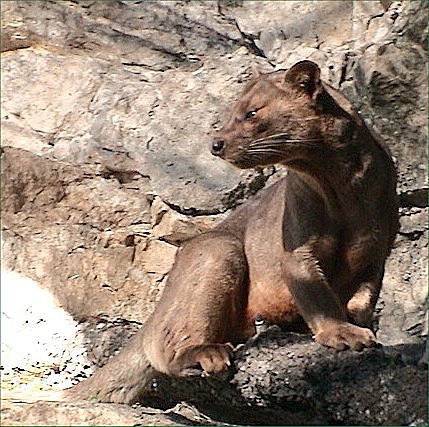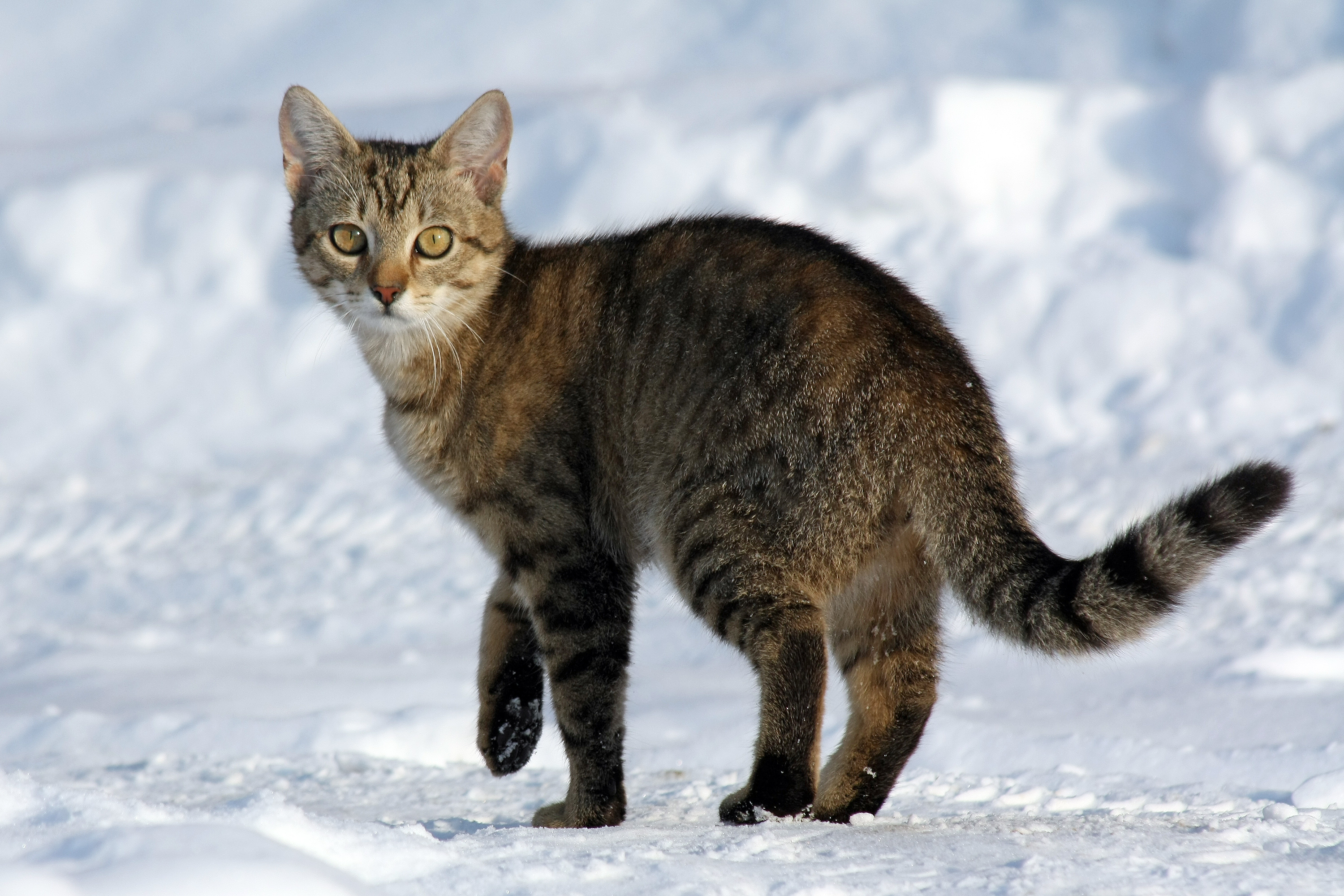|
Feliformia
Feliformia is a suborder within the order Carnivora consisting of "cat-like" carnivorans, including Felidae, cats (large and small), hyenas, mongooses, viverrids, and related taxa. Feliformia stands in contrast to the other suborder of Carnivora, Caniformia consisting of "dog-like" carnivorans (includes Canoidea). The separation of the Carnivora into the broad groups of feliforms and caniforms is widely accepted, as is the definition of Feliformia and Caniformia as suborders (sometimes superfamilies). The classification of feliforms as part of the Feliformia suborder or under separate groupings continues to evolve. Systematic classifications dealing with only extant taxa include all feliforms into the Feliformia suborder, though variations exist in the definition and grouping of families and genera.Taxonomic references - extant species (1): Supporting descriptive information and picturesDiversity Web (online) – Feliformia/ref>Taxonomic references - extant species (2)Integrated ... [...More Info...] [...Related Items...] OR: [Wikipedia] [Google] [Baidu] |
Aeluroidea
Aeluroidea, Ailuroidea, or Feloidea is the name of a taxon (infraorder or superfamily) comprising cat-like Carnivora. More specifically the taxon comprises:Feliformia, Pan-Feliformia. In: R. L. Carroll. 1988. Vertebrate Paleontology and Evolution. W. H. Freeman and Company, New York 1-698H. N. Bryant. 1991. Phylogenetic relationships and systematics of the Nimravidae (Carnivora). Journal of Mammalogy 72(1):56-78 * either cat-like Carnivora in the broader sense, i.e. it is synonymous with Feliformia (more specifically either Feliformia sensu stricto, i.e. crown Feliformia, or Feliformia sensu lato, i.e. Pan-Feliformia); * or cat-like Carnivora in the narrower sense, i.e. it comprises only the family Felidae (recently also Prionodontidae) and its closest extinct relatives. The Aeluroidea in the first, i.e. broader sense, has been sometimes called infraorder Aeluroida since 1982. The name Feloidea is sometimes used in a third sense—it designates the taxon corresponding to all Fel ... [...More Info...] [...Related Items...] OR: [Wikipedia] [Google] [Baidu] |
Carnivora
Carnivora ( ) is an order of placental mammals specialized primarily in eating flesh, whose members are formally referred to as carnivorans. The order Carnivora is the sixth largest order of mammals, comprising at least 279 species. Carnivorans are found on every major landmass and in a variety of habitats, ranging from the cold polar regions of Earth to the hyper-arid region of the Sahara Desert and the open seas. Carnivorans exhibit a wide array of body plans, varying greatly in size and shape. Carnivora are divided into two suborders, the Feliformia, containing the true felids and several animals; and the Caniformia, containing the true canids and many animals. The feliforms include the Felidae, Viverridae, hyena, and mongoose families, the majority of which live only in the Old World; cats are the only exception, occurring in the Old World and the New World, entering the Americas via the Bering land bridge. The caniforms include the Caninae, Procyonidae, bears, ... [...More Info...] [...Related Items...] OR: [Wikipedia] [Google] [Baidu] |
Nimravidae
Nimravidae is an extinct family (biology), family of carnivorans, sometimes known as false saber-toothed cats, whose fossils are found in North America and Eurasia. Not considered to belong to the true cats (family Felidae), the nimravids are generally considered closely related and classified as a distinct family in the suborder Feliformia. Fossils have been dated from the Middle Eocene through the Late Oligocene epochs (Bartonian through Chattian stages, 41.03–25.9 million years ago), spanning about . The barbourofelids, which were formerly classified as a subfamily of the Nimravidae, were reassigned to their own distinct family Barbourofelidae in 2004. However in the 2020s, some studies suggest the barbourofelids are a branch of the nimravids, suggesting that this debate might not be settled yet. If accepted, the family would have persisted until the Late Miocene, and would extend their spatial distribution to Africa. Taxonomy The family Nimravidae was named by American pale ... [...More Info...] [...Related Items...] OR: [Wikipedia] [Google] [Baidu] |
Two-spotted Palm Civet
The African palm civet (''Nandinia binotata''), also known as the two-spotted palm civet, is a small Feliformia, feliform mammal widely distributed in sub-Saharan Africa. It is listed as least concern on the IUCN Red List. Characteristics The African palm civet is grey to dark brown with dark spots on the back. It has short legs, small ears, a lean body, and a long, ringed tail. It has two sets of scent glands on the lower abdomen and between the third and fourth toes on each foot, which secrete a strong-smelling substance used to mark territory and in mating. Adult females reach a body length of with a long tail and weigh . Adult males reach in body length with a long tail and weigh . The African palm civet's ear canal is not divided and cartilaginous at the end. Distribution and habitat The African palm civet ranges throughout much of sub-Saharan Africa from Guinea to South Sudan, south to Angola, and into eastern Zimbabwe. It has been recorded in deciduous forests, lowla ... [...More Info...] [...Related Items...] OR: [Wikipedia] [Google] [Baidu] |
Nandinioidea
The African palm civet (''Nandinia binotata''), also known as the two-spotted palm civet, is a small feliform mammal widely distributed in sub-Saharan Africa. It is listed as least concern on the IUCN Red List. Characteristics The African palm civet is grey to dark brown with dark spots on the back. It has short legs, small ears, a lean body, and a long, ringed tail. It has two sets of scent glands on the lower abdomen and between the third and fourth toes on each foot, which secrete a strong-smelling substance used to mark territory and in mating. Adult females reach a body length of with a long tail and weigh . Adult males reach in body length with a long tail and weigh . The African palm civet's ear canal is not divided and cartilaginous at the end. Distribution and habitat The African palm civet ranges throughout much of sub-Saharan Africa from Guinea to South Sudan, south to Angola, and into eastern Zimbabwe. It has been recorded in deciduous forests, lowland rainfor ... [...More Info...] [...Related Items...] OR: [Wikipedia] [Google] [Baidu] |
Caniformia
Caniformia is a suborder within the order Carnivora consisting of "dog-like" carnivorans. They include Canidae, dogs (Wolf, wolves, foxes, etc.), bears, raccoons, and Mustelidae, mustelids. The Pinnipedia (pinniped, seals, walruses and sea lions) are also assigned to this group. The center of diversification for the Caniformia is North America and northern Eurasia. Caniformia stands in contrast to the other suborder of Carnivora, the Feliformia ("cat-like" carnivorans), the center of diversification of which was in Africa and United Nations geoscheme for Asia#Southern Asia, southern Asia. Description Most members of this group have nonretractile claws (the Fisher (animal), fisher, marten, sea otter (Forepaw, forepaws only), red panda, and Bassariscus astutus, ringtail, and some foxes have retractile or semi-retractile claws) and tend to be plantigrade (with the exception of the Canidae). Other traits that separate the Caniformia from the Feliformia is that caniforms have longer ja ... [...More Info...] [...Related Items...] OR: [Wikipedia] [Google] [Baidu] |
Felidae
Felidae ( ) is the Family (biology), family of mammals in the Order (biology), order Carnivora colloquially referred to as cats. A member of this family is also called a felid ( ). The 41 extant taxon, extant Felidae species exhibit the greatest diversity in fur patterns of all terrestrial carnivores. Cats have retractile claws, slender muscular bodies and strong flexible forelimbs. Their teeth and facial muscles allow for a powerful bite. They are all obligate carnivores, and most are solitary predators ambushing or stalking their prey. Wild cats occur in Africa, Europe, Asia and the Americas. Some wild cat species are adapted to forest and savanna habitats, some to arid environments, and a few also to wetlands and mountainous terrain. Their activity patterns range from nocturnal and crepuscular to Diurnality, diurnal, depending on their preferred prey species. Reginald Innes Pocock divided the extant Felidae into three subfamilies: the Pantherinae, the Felinae and the Acin ... [...More Info...] [...Related Items...] OR: [Wikipedia] [Google] [Baidu] |
Eupleridae
Eupleridae is a Family (biology), family of carnivorans endemic to Madagascar and comprising 10 known living species in seven genus, genera, commonly known as euplerids, Malagasy mongooses or Malagasy carnivorans. The best known species is the Fossa (animal), fossa (''Cryptoprocta ferox''), in the subfamily Euplerinae. All species of Euplerinae were formerly classified as Viverridae, viverrids, while all species in the subfamily Galidiinae were classified as Herpestidae, herpestids. Recent molecular studies indicate that the 10 living species of Madagascar carnivorans evolved from one ancestor that is thought to have Oceanic dispersal, rafted over from mainland Africa 18–24 million years ago. This makes Malagasy carnivorans a clade. They are closely allied with the true herpestid mongooses, their closest living relatives. The fossa and the Malagasy civet (''Fossa fossana'') are each evolutionarily quite distinct from each other and from the rest of the clade. All ... [...More Info...] [...Related Items...] OR: [Wikipedia] [Google] [Baidu] |
Viverridae
Viverridae is a family (biology), family of small to medium-sized feliform mammals, comprising 14 genera with 33 species. This family was named and first described by John Edward Gray in 1821. Viverrids occur all over Africa, in southern Europe, South Asia, South and Southeast Asia on both sides of the Wallace Line. The word viverridae comes from the Latin word . The species of the subfamily Genettinae are known as Genet (animal), genets and Poiana (genus), oyans. The viverrids of the subfamily Viverrinae are commonly called civets; the Paradoxurinae and most Hemigalinae species are called palm civets. Characteristics Viverrids have four or five toes on each foot and half-retractile claws. They have six incisors in each jaw and Molar (tooth), molars with two tubercular grinders behind in the upper jaw, and one in the lower jaw. The tongue is rough with sharp prickles. A pouch or Anal gland, gland occurs beneath the anus, but there is no cecum. The male's Urinary meatus, urethr ... [...More Info...] [...Related Items...] OR: [Wikipedia] [Google] [Baidu] |
Fossa (animal)
The fossa (''Cryptoprocta ferox''; or ; ) is a slender, long-tailed, cat-like mammal that is endemic to Madagascar. It is a member of the carnivora, carnivoran family Eupleridae. The fossa is the largest mammalian carnivore on Madagascar and has been compared to a small cougar, as it has Convergent evolution, convergently evolved many cat-like features. Adults have a head-body length of and weigh between , with the males larger than the females. It has semi-retractable claws (meaning it can extend but not retract its claws fully) and flexible ankles that allow it to climb up and down trees head-first, and also support jumping from tree to tree. A larger relative of the species, ''Cryptoprocta spelea'', probably became extinct before 1400. The species is widespread, although population density, population densities are usually low. It is found solely in forested habitat, and actively hunts both by day and night. Over 50% of its diet consists of lemurs, the endemic primates f ... [...More Info...] [...Related Items...] OR: [Wikipedia] [Google] [Baidu] |
Palaeogalidae
''Palaeogale'' is an extinct genus of carnivorous mammal known from the Late Eocene, Oligocene, and Early Miocene of North America, Europe, and Eastern Asia. A small carnivore often associated with the mustelids, ''Palaeogale'' might have been similar to living genets, civets, and linsangs. Time range The ancestry of ''Palaeogale'' remains enigmatic. The genus appears in Europe 32 Ma, after the Grande Coupure, but 35-36 Ma-old ( Chadronian NALMA) specimens from Pipestone Springs, Montana, are the oldest known. ''Palaeogale'' survived until the late Early Miocene of Europe and the early Early Miocene of East Asia. noted that the ''Palaeogale'' specimens found in Mongolia are the most plesiomorphic (p1 double-rooted, m2 relatively large, very small overall size) and that the genus probably originated there and migrated to Europe and North America. Anatomy ''Palaeogale'' was the size of a small mustelid but had a hypercarnivorous dentition and its taxonomic position remains en ... [...More Info...] [...Related Items...] OR: [Wikipedia] [Google] [Baidu] |







